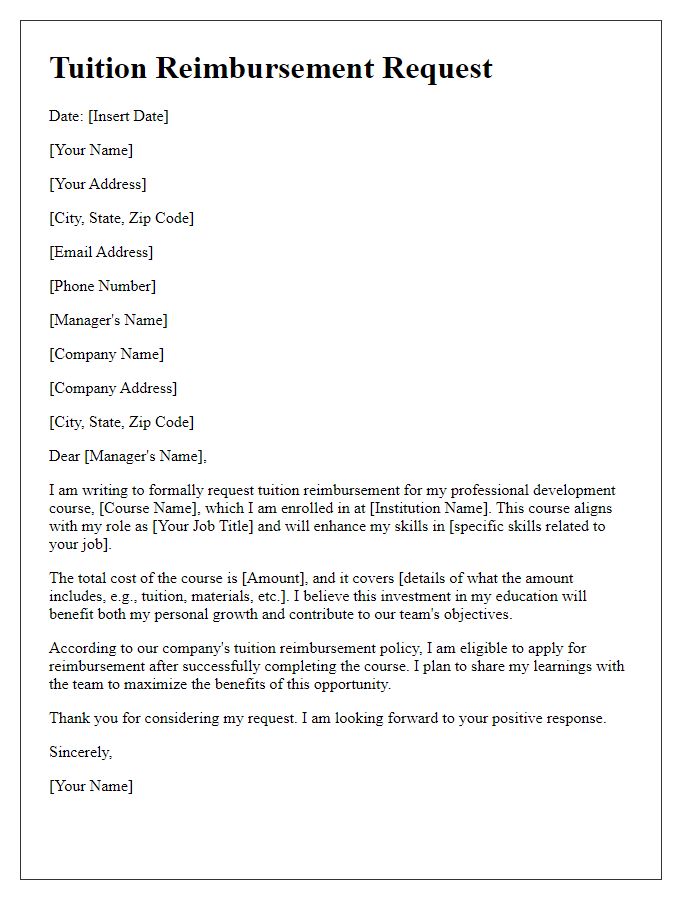Are you considering pursuing further education while balancing your job? Navigating the process of tuition reimbursement can seem daunting, but it doesn't have to be. In this article, we'll guide you through an effective letter template that will help you articulate your request for tuition reimbursement clearly and professionally. So, grab a cup of coffee and let's dive into how to make your request stand out!

Employee Information
The employee information section for tuition reimbursement requests typically includes essential details about the individual seeking the reimbursement. Standard entries might consist of the employee's full name, identification number, department, position title, and contact information, such as phone number and email address. Additionally, the request might specify the date of the request, along with relevant course details including the title of the course, institution's name, enrollment dates, and the total amount of tuition fees. Precise documentation is crucial to ensure clarity and streamline the review process for the reimbursement request.
Course Details
Tuition reimbursement programs can be a valuable resource for employees seeking to advance their skills and education while working. Specific courses, such as "Advanced Data Analysis," often offered by accredited institutions like Stanford University, are part of professional development programs. These courses typically cover critical topics, including statistics, data manipulation techniques, and predictive modeling, essential for enhancing job performance. Employees may seek reimbursement ranging from 50% to 100% of course fees, dependent on company policies, with potential costs exceeding $2,000 for a semester. Timely submission of documentation, including proof of enrollment and grades, is crucial for reimbursement approval.
Relevance to Job Role
Employees seeking tuition reimbursement should highlight how their educational pursuits align with their job responsibilities and overall company objectives. For instance, completing a Master's degree in Business Administration (MBA) can enhance managerial skills essential for leading projects, developing strategies, and improving team performance. Courses in data analysis or project management can directly improve productivity and efficiency within specific departments. Additionally, training in communication skills fosters better collaboration among team members, directly impacting workplace culture and project success rates. Documenting the direct benefits of the coursework to the employee's role can strengthen the tuition reimbursement request and demonstrate the value of investing in employee development.
Cost Breakdown
Tuition reimbursement programs allow employees to recoup educational expenses from their companies. Cost breakdown typically includes tuition fees, which can average from $500 to $2,000 per course depending on the institution's rank, including renowned universities such as Harvard or Stanford. Additional costs like books often average around $150 to $400 per semester for essential texts. Transportation fees, especially in metropolitan areas such as New York City or San Francisco, can add another $100 monthly for commuting. Lastly, fees for online courses may also be included, with technology fees ranging from $50 to $200 per semester. Each item in this detailed cost breakdown provides a comprehensive view of the financial investment needed for education.
Anticipated Benefits
Anticipated benefits of tuition reimbursement programs for employees include increased employee satisfaction, enhanced skill sets, and improved organizational performance. Investing in employee education often leads to higher retention rates, with studies indicating that companies offering tuition reimbursement programs see a 10-30% decrease in turnover. Skilled employees can improve productivity, potentially leading to revenue growth, which could increase by up to 25% in some sectors. Furthermore, specialized training helps employees stay updated with industry trends, promoting innovation within the organization. Companies can also enhance their reputation as desirable employers, attracting top talent in competitive job markets. Overall, these benefits create a culture of continuous learning, driving overall success for the organization.
Letter Template For Tuition Reimbursement Request Samples
Letter template of tuition reimbursement request for professional development

Letter template of tuition reimbursement request for certification programs

Letter template of tuition reimbursement request with supporting documents











Comments